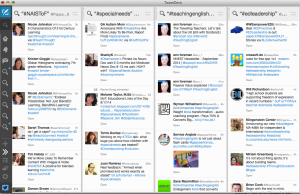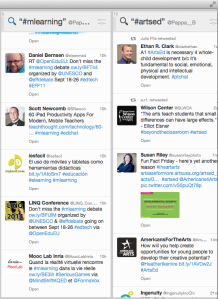Safeguarding My Digital Identity – My Plan B
September 28, 2014 6 Comments
Reflecting on my Digital Footprint post, I found evidence that leads me to believe we should be thinking in terms of when we were children making footprints in freshly poured cement. Our images, postings and other things projected on the Internet are less like washable sand and more like concrete casts. The concrete does not care whether the mold is appropriate or not. It is left for generations to come. We must be certain that we do what we can to be prudent prior to the mold setting.
Continuing from the knowledge gained in my Digital Footprint search, I researched the materials offered in our Resources this week and spent time exploring guides and documents by others. I ended up creating a plan that represents me and my intent to become digitally savvy. I have identified many weaknesses in establish and monitoring my professional digital identity. I intend to put this plan into practice to improve my brand and my image to represent my best me going forward.
References:
Anderson, S., (n.d.). How to create social media guidelines for your school. Edutopia. Retrieved from http://www.edutopia.org/social-media-guidelines-resource-guide
Blankenship, S. (2012). Social media and two-way communication. Connected Principals. Retrieved from http://connectedprincipals.com/archives/5710
Camp, L. J. (2004). Digital identity. IEEE Technology & Society Magazine, 23(3). 34-41.
Costa, C., & Torres, R. (2011). To be or not to be, the importance of Digital Identity in the networked society. Educação, Formação & Tecnologias, n.º extra, Abril de 2011, 47-53. Retrieved from http://www.eft.educom.pt/index.php/eft/article/view/216
George, R., Don, P., & Patel, U. (2003). Mobile identity management: An enacted view. International Journal of Electronic Commerce, 8(1), 81-100.
Lowenthal, P., & Dunlap, J. (2012). Intentional web presence: 10 SEO strategies every academic needs to know. Educause Review Online, Retrieved from http://www.educause.edu/ero/article/intentional-web-presence-10-seo-strategies-every-academic-needs-know
McGinnis, S. (2012). Online reputation management: A how-to guide. Spinsucks. Retrieved from http://spinsucks.com/communication/online-reputation-management-a-how-to-guide/
Simpson, M. (2010). Social networking nightmares. Tomorrow’s Teachers. Retrieved from http://www.nea.org//home/38324.htm
Image Credits:
Image fingerprint –http://pixabay.com/static/uploads/photo/2012/12/14/11/36/binary-69996_640.jpg
Online Identity – http://tinyurl.com/oo86arn
Identity Card – http://upload.wikimedia.org/wikipedia/commons/e/eb/National_Registration_Identity_Card_%28Front_Cover%29.png
Websearch – http://upload.wikimedia.org/wikipedia/commons/7/75/Internet1.jpg
Mobile Bicycle Billboard – http://upload.wikimedia.org/wikipedia/commons/6/6c/Mobile_Bicycle_Billboard_from_Singapore,_April_9_2013.jpg
Faceebook – https://farm3.staticflickr.com/2705/13203226213_c1eee42fb9_t.jpg
NetworkLearner – http://upload.wikimedia.org/wikipedia/commons/8/81/Network_learner.jpg
Digifest2014 – http://www.jisc.ac.uk/sites/default/files/digifest-news.jpg
Padlocks – http://farm8.static.flickr.com/7228/6889241086_daf439e6b7.jpg
FlipflopIcons – http://fc00.deviantart.net/fs71/i/2010/014/8/5/Flip_Flop_Social_Media_Icons_by_EffBomb.jpg
GoogleSEO – http://pixabay.com/p-411105/?no_redirect






